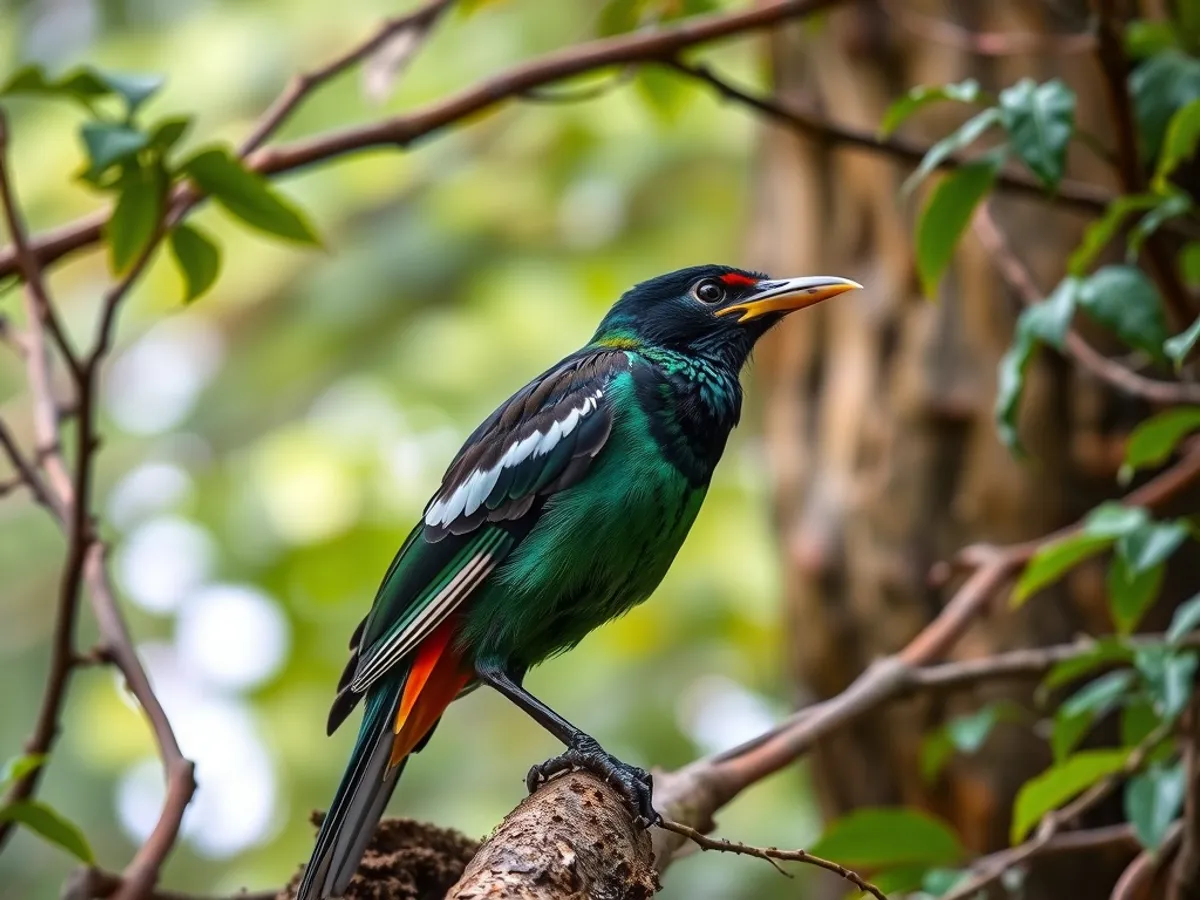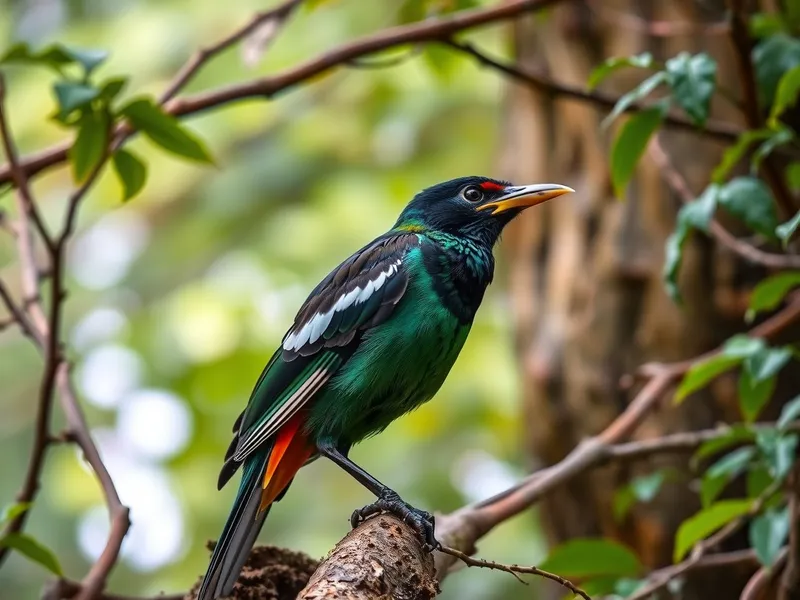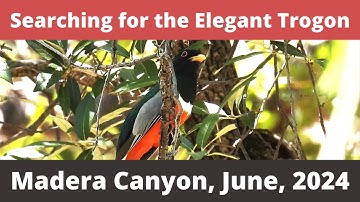
Elegant Trogon
Trogon elegans

Meet the Elegant Trogon
The Elegant Trogon is a strikingly colorful bird, notable for its metallic green head, bright red belly, and contrasting white breast band. Found primarily in the canyons and woodlands of the southwestern United States, Mexico, and Central America, this species is often sought after by birdwatchers for its vivid plumage and unique vocalizations. Elegant Trogons nest in tree cavities and are typically seen singly or in pairs, moving quietly through the mid-story of forests. Their presence is often detected by their low, repetitive calls rather than by sight.
Classification
Bird
Habitat
Woodland and forested canyons
Diet
Omnivore
Lifespan
5-8 years
Conservation
Least Concern
Weight
60-70 grams
📖Fascinating Facts
Cavity Nesters
Elegant Trogons often nest in natural cavities or abandoned woodpecker holes, typically choosing sites several meters above the ground.
Varied Diet
Their diet consists of insects, fruits, and small invertebrates, making them important for both pest control and seed dispersal in their ecosystems.
Vivid Plumage
Males display brilliant metallic green upperparts and a red belly, while females are more muted with brownish tones but still possess a distinctive white breast band.
📋Detailed Description
The Elegant Trogon (Trogon elegans) is a medium-sized bird, measuring approximately 28–30 cm (11–12 in) in length and weighing 60–80 grams. Males are especially striking, with iridescent emerald-green heads, upper breasts, and backs, a bold white breast band, and a vivid red belly; females are more subdued, with olive-brown upperparts and a paler red belly. Both sexes have a distinctive squared tail with white undertail coverts and a coppery-bronze tail underside, which gives rise to the former name 'coppery-tailed trogon.' The bill is short, broad, and yellow, adapted for fruit and insect consumption. Their large, dark eyes are well-suited for foraging in dim forest understories. Elegant Trogons are generally solitary or found in pairs, moving quietly through the mid-story and lower canopy. Their flight is undulating and somewhat sluggish, with short bursts between perches. Vocalizations are low, repetitive, croaking calls, often heard before the bird is seen. They are cavity nesters, typically utilizing abandoned woodpecker holes or natural tree cavities, which they may further excavate using their serrated bills. The species is non-migratory in most of its range but exhibits seasonal movements in the northernmost populations, particularly in the southwestern United States.
💡 Did you know?
The Elegant Trogon’s call is a low, repetitive 'kow' sound that can travel great distances through the forest.
🔬Research & Sources
Wikipedia Summary
The elegant trogon, previously known as the coppery-tailed trogon, is a near passerine bird in the trogon family native to Central America. The etymology of the word trogon comes from the Greek word trōgein, meaning "to gnaw", which describes how this species prepares its nests in trees.
Last Modified: 5/25/2025
🎭Behavior & Social Structure
Elegant Trogons are primarily diurnal and spend much of their day foraging in the mid-story of forests and woodlands. Their diet is omnivorous, consisting largely of small fruits and berries, supplemented by insects such as caterpillars, beetles, grasshoppers, and occasionally small vertebrates like lizards. They employ a sit-and-wait hunting strategy, sallying from perches to snatch prey or pluck fruit. Socially, they are most often observed singly or in monogamous pairs, especially during the breeding season. Territorial during nesting, males will defend their chosen area with vocalizations and displays. Outside the breeding season, they may be loosely associated with mixed-species foraging flocks. Roosting occurs in dense foliage, and they are known for their secretive, unobtrusive movements, often going unnoticed despite their vivid colors.
👶Reproduction & Life Cycle
Breeding typically occurs from April to July, with timing varying by latitude and elevation. Courtship involves males displaying their plumage and calling persistently to attract females. Once paired, both sexes participate in selecting and preparing a nest site, usually an abandoned woodpecker cavity or natural hole in a decaying tree, 2–10 meters above ground. The female lays 2–4 white eggs, which are incubated for about 17–19 days, primarily by the female, though the male may assist. After hatching, both parents feed the nestlings a diet of insects and fruit. The young fledge at around 16–18 days old but may remain dependent on parental care for several weeks. Elegant Trogons typically raise a single brood per season.
🛡️Adaptations & Survival
Elegant Trogons possess several adaptations for their arboreal lifestyle. Their zygodactyl feet (two toes forward, two backward) provide a strong grip on branches and aid in maneuvering through dense foliage. The broad, hooked bill is specialized for plucking fruit and catching insects. Their cryptic behavior and preference for dense cover help them avoid predators. The vivid coloration of males may play a role in mate attraction and territorial displays, while the more subdued plumage of females offers camouflage during nesting. The ability to utilize existing cavities for nesting reduces the energetic cost of nest construction and allows them to exploit a variety of woodland habitats.
🎨Cultural Significance
The Elegant Trogon holds a special place among birdwatchers in the southwestern United States, where it is considered a 'holy grail' species due to its rarity and beauty. In Mexican and Central American folklore, trogons are sometimes associated with forest spirits and are admired for their vibrant plumage. While not as culturally prominent as the Resplendent Quetzal, the Elegant Trogon is occasionally featured in local art and ecotourism materials, symbolizing the rich biodiversity of the region's forests.
🔬Recent Research & Discoveries
Recent research has focused on the Elegant Trogon's habitat preferences, breeding ecology, and the effects of habitat fragmentation on its distribution. Studies using bioacoustic monitoring have improved understanding of territory size and vocalization patterns. Genetic analyses have clarified relationships among trogon species and subspecies, supporting the distinction of several regional forms. Ongoing research in Arizona and New Mexico tracks population trends and responses to climate change, emphasizing the need for habitat conservation in riparian woodlands.
🎥Wildlife Videos

Elegant Trogons and other birds of Arizona
In this action-packed BATV episode host James Currie and the guides from the Adventure Birding Company go in quest of ...
A WILD Connection

Searching for the Elegant Trogon in Madera Canyon, AZ
Welcome back to The Birding Voyage. In this adventure we explore the amazing Madera Canyon in Arizona. I search for my ...
The Birding Voyage

30 Most Beautiful Creatures On Earth (Order Galliformes) | Wildlife Documentary | BBTV Official
In the heart of the world's most remote forests and rugged highlands, where mist lingers over ancient trees and the wilderness ...
BBTV Official

The Skills Of Smart Birds | DOCUMENTARY
The Skills Of Smart Birds - These child prodigies of the animal kingdom have feathers and beaks – and very special skills!
Travel Universe

Trogon bird Marvels of Trogon Birds Exploring Nature's Palette, Bird Watcher
Dive into the mesmerizing world of Trogon birds, where vibrant hues paint the skies and forests with breathtaking beauty.
Bird Watcher

Birds Of US | Most Beautiful Birds In The United States | Wildlife Documentary | BBTV Official
Welcome to BBTV Official, In this celebration of avian splendor, we delve into the lives of the most beautiful birds across the United ...
BBTV Official
🌍Habitat Information
The Elegant Trogon typically inhabits Woodland and forested canyons environments. Elegant Trogons have adapted to their environments with specialized features and behaviors.
Primary Habitat:
Woodland and forested canyons
More detailed habitat information will be available soon.
🛡️Conservation Status
The Elegant Trogon is currently classified as Least Concern. Conservation efforts are crucial for preserving this species for future generations.
Common Threats:
- 🏠Habitat loss and fragmentation
- 🌡️Climate change impacts
- 🎯Hunting and poaching
- 🏭Human-wildlife conflict
⚠️Threats & Conservation Challenges
While the Elegant Trogon is currently listed as Least Concern by the IUCN, localized threats include habitat loss due to deforestation, agricultural expansion, and urban development, particularly in the northern parts of its range. The species is sensitive to the removal of large, mature trees, which provide essential nesting cavities. Insecticide use may reduce prey availability. Climate change could impact the availability of suitable habitat and alter the timing of food resources. Despite these challenges, populations remain stable across most of their range, though they are considered rare and vulnerable at the northern edge, especially in the United States.
🔬Scientific Classification
Scientific Name
Trogon elegans
Classification Hierarchy
🔍 About Taxonomic Classification
Taxonomic classification is a hierarchical system used by scientists to classify and organize living organisms based on shared characteristics and evolutionary relationships.
The system moves from broad categories (Kingdom) to increasingly specific ones, with each animal's scientific name typically consisting of its Genus and species.
📝Community Notes
Share your observations and insights about the Elegant Trogon with our community of wildlife enthusiasts.
Join Our Community
Sign in to share your observations and connect with fellow wildlife enthusiasts.
Sign In to ContributeNo community notes yet
Be the first to share your observations about the Elegant Trogon!
Explore Elegant Trogon
Select a tab above to learn more about this amazing animal.
📸Photo Gallery
No photos available for this animal yet.
🌟Discover More Wildlife
Continue your journey of discovery with more fascinating animals from our database
